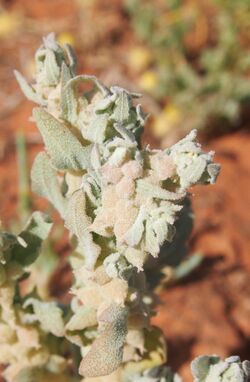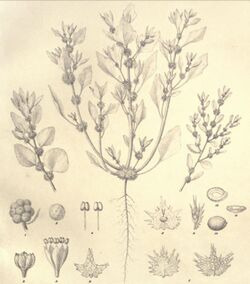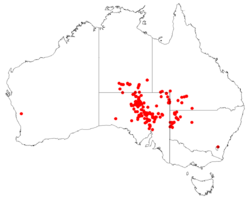Biology:Atriplex fissivalvis
| Atriplex fissivalvis | |
|---|---|

| |
| Atriplex fissivalvis fruit | |

| |
| from Mueller 1889[1] | |
| Scientific classification | |
| Kingdom: | Plantae |
| Clade: | Tracheophytes |
| Clade: | Angiosperms |
| Clade: | Eudicots |
| Order: | Caryophyllales |
| Family: | Amaranthaceae |
| Genus: | Atriplex |
| Species: | A. fissivalvis
|
| Binomial name | |
| Atriplex fissivalvis | |

| |
| Occurrence data from AVH | |
| Synonyms[4] | |
|
Haloxanthium fissivalve (F.Muell.) Ulbr. | |
Atriplex fissivalvis, commonly known as gibber saltbush, is a plant species in the family Amaranthaceae, subfamily, Chenopodioideae.[2] It occurs in the Australia n states of South Australia, New South Wales, Queensland and the Northern Territory.[5][6][7][8]
Description
Atriplex fissivalvis is an annual monoecious herb 10–30 centimetres (4–12 in) high, which branches from the base.[7] The leaves (on a stalk of 5–10 millimetres (0.2–0.4 in)) are about 20 millimetres (1 in) long, with toothed or sinuate margins and an acute apex.[5][7] It flowers in clusters[2] in the axils of leaves,[7] from June to November (in the Northern Territory).[8] Fruiting is from June to November (in the Territory),[8] and the fruit is without a stem and enclosed in bracteoles.[7]
Distribution
In the Northern Territory it is found in the IBRA regions of Finke, MacDonnell Ranges, Simpson Strzelecki Dunefields, and Stony Plains.[8]
Taxonomy & naming
Atriplex fissivalvis was first described by Mueller in 1875.[2][3] The specific epithet, fissivalvis, comes from the Latin, fissus (cleft) and -valvis (-valved), giving "split-valved".[9]
Similar taxa
"Atriplex fissivalvis could be confused with A. lobativalvis, however the latter has fruiting bracteoles that lack appendages on the dorsal surface, are prominently keeled or have a raised area on the lower dorsal surface, have margins that are fused for over one-third their length, and has a preference for freshwater swamps and claypans."[8]
Conservation status
The Northern Territory lists this species as "Near Threatened" under the TPWCA act.[8]
References
- ↑ von Mueller, F.J.H. (1889) Iconography of Salsolaceous Plants I R.S. Brain, Government Printer, Melbourne.
- ↑ 2.0 2.1 2.2 2.3 "APNI Atriplex fissivalvis". IBIS database. https://biodiversity.org.au/nsl/services/rest/name/apni/111364/api/apni-format. Retrieved 6 July 2018.
- ↑ 3.0 3.1 von Mueller, F.J.H. (1875) Fragmenta Phytographiae Australiae 9(77): 123
- ↑ Govaerts, R.. "Plants of the World online Atriplex fissivalvis". Board of Trustees of the Royal Botanic Gardens, Kew. https://powo.science.kew.org/taxon/urn:lsid:ipni.org:names:163796-1. Retrieved 6 July 2018.
- ↑ 5.0 5.1 S.W.L. Jacobs. "New South Wales Flora Online: Atriplex fissivalvis". Royal Botanic Gardens & Domain Trust, Sydney, Australia. http://plantnet.rbgsyd.nsw.gov.au/cgi-bin/NSWfl.pl?page=nswfl&lvl=sp&name=Atriplex~fissivalvis.
- ↑ AVH Occurrence data: Atriplex fissivalvis
- ↑ 7.0 7.1 7.2 7.3 7.4 "Atriplex fissivalvis F.Muell". State Herbarium of South Australia. http://www.flora.sa.gov.au/cgi-bin/texhtml.cgi?form=speciesfacts&family=&genus=Atriplex&species=fissivalvis&iname=&submit=Search.
- ↑ 8.0 8.1 8.2 8.3 8.4 8.5 "NTflora: factsheet for Atriplex fissivalvis". Northern Territory Government. http://eflora.nt.gov.au/factsheet?id=1121. Retrieved 6 July 2018.
- ↑ Stearn, W.T. (2004) Botanical Latin, 4th ed. pp. 413, 523. Timber Press, Oregon.
External links
Wikidata ☰ Q15584195 entry
 |

